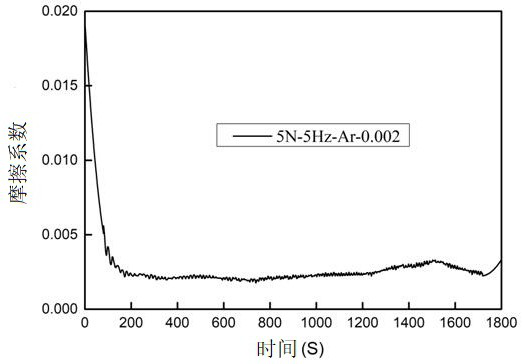A kind of ultra-slippery metal/hydrogen-containing carbon composite film and preparation method thereof
A carbon thin film and carbon composite technology, which is applied in the field of solid lubrication and tribology, can solve the problems of harsh super-slip conditions, difficult engineering applications, and large environmental dependence, so as to improve the bonding force of the film, increase the service life, and facilitate engineering applications Effect
- Summary
- Abstract
- Description
- Claims
- Application Information
AI Technical Summary
Problems solved by technology
Method used
Image
Examples
Embodiment 1
[0026] (1) Clean the stainless steel substrate with water-based cleaning solution and hydrocarbon cleaning solution in an ultrasonic cleaning tank to remove oil, rust and pollutants, then dry it with nitrogen, and put it into a coating vacuum chamber;
[0027] (2) Pump the vacuum system to 2.0×10 through the mechanical pump, Roots pump and molecular pump in sequence -3 Pa and below, turn on the hollow cathode ion source, adjust the current to 400A, and the bias voltage to 500; pass in argon gas, keep the pressure at 1Pa, and bombard and clean for 200 minutes to further remove the substrate surface pollutants;
[0028] (3) Turn on the magnetron sputtering target (the target is Cr metal), adjust the peak current to 200A, the bias voltage to 300 V, adjust the argon gas to 0.5Pa, and deposit for 20 minutes; feed 15% nitrogen and 35% methane ( Compared with argon), adjust the current to 15A, bias to 300V, adjust the argon to 0.5, deposit for 40 minutes, and obtain a metal carbonitr...
Embodiment 2
[0033] (1) Clean the mold steel substrate with water-based cleaning solution and hydrocarbon cleaning solution in an ultrasonic cleaning tank to remove oil stains, rust spots and pollutants, then dry it with nitrogen, and place it in a coating vacuum chamber;
[0034] (2) Pump the vacuum system to 2.0×10 through the mechanical pump, Roots pump and molecular pump in sequence -3 Pa and below, turn on the hollow cathode ion source, adjust the current to 200A, and the bias voltage to 800V. Introduce argon gas, keep the air pressure at 5Pa, and bombard and clean for 30 minutes to further remove pollutants on the sample or substrate surface;
[0035] (3) Turn on the magnetron sputtering target (the target is Ti), adjust the peak current to 200A, the bias voltage to 300-500V, adjust the argon gas to 1.5Pa, deposit for 40 minutes; feed 10% nitrogen, 25-35% Methane (compared with argon), adjust the current 0.5-15A, bias 300-500V, adjust the argon to 0.5-1.5Pa, deposit for 40-60 minute...
Embodiment 3
[0040] (1) Clean the silicon wafer substrate with water-based cleaning solution and hydrocarbon cleaning solution in an ultrasonic cleaning tank to remove oil, rust and pollutants, then dry it with nitrogen, and put it into a coating vacuum chamber;
[0041] (2) Pump the vacuum system to 2.0×10 through the mechanical pump, Roots pump and molecular pump in sequence -3 Pa and below, turn on the hollow cathode ion source, adjust the current to 300A, and the bias voltage to 600V. Introduce argon gas, keep the air pressure at 3Pa, and bombard and clean for 30 minutes to further remove pollutants on the sample or substrate surface;
[0042] (3) Turn on the magnetron sputtering target (the target is Ti), adjust the peak current to 200A, the bias voltage to 300-400V, adjust the argon gas to 1Pa, and deposit for 30 minutes; Argon gas comparison), adjust the current 6A, bias voltage 500V, adjust the argon gas to 1.5Pa, deposit for 40 minutes, and obtain a metal carbonitride transition ...
PUM
| Property | Measurement | Unit |
|---|---|---|
| thickness | aaaaa | aaaaa |
| thickness | aaaaa | aaaaa |
| thickness | aaaaa | aaaaa |
Abstract
Description
Claims
Application Information
 Login to View More
Login to View More - R&D
- Intellectual Property
- Life Sciences
- Materials
- Tech Scout
- Unparalleled Data Quality
- Higher Quality Content
- 60% Fewer Hallucinations
Browse by: Latest US Patents, China's latest patents, Technical Efficacy Thesaurus, Application Domain, Technology Topic, Popular Technical Reports.
© 2025 PatSnap. All rights reserved.Legal|Privacy policy|Modern Slavery Act Transparency Statement|Sitemap|About US| Contact US: help@patsnap.com


